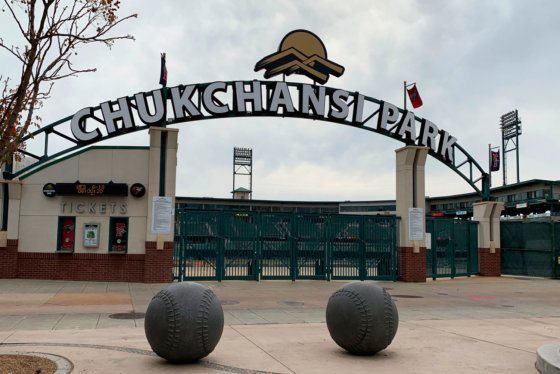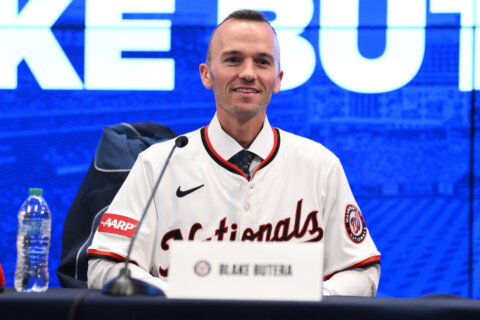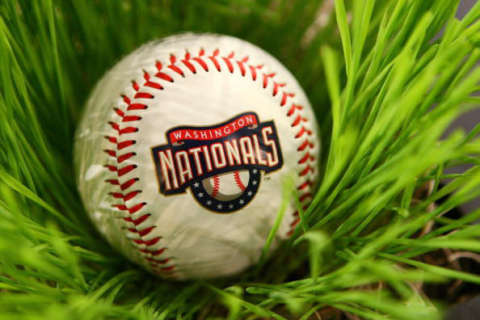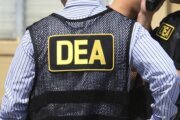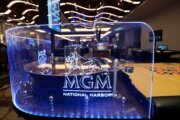Wait, Fresno? Really? What are we — and what is the Washington Nationals’ Triple-A team — doing in Fresno, California?
Understanding the bizarre twists and turns that forged an unlikely marriage between the Nats and the Fresno Grizzlies requires some historical background on the decisions beyond their control that pushed them together. And understanding Fresno as a place requires more than a reliance on pop culture’s easy, plentiful punchlines.
***
The Dance
How did this happen? How did the Nationals end up with their Triple-A team playing more than 2,700 miles from Washington, the second-furthest distance between any big league club and stateside affiliate at any level of the minor leagues? Players are just a missed bunt or a bullpen implosion away from the big leagues, but few places feel as physically far away from Washington.
The first sign of trouble came in the fall of 2017, when the New York Mets purchased the Syracuse Chiefs, despite the fact that the team was under affiliation with the Nats. With another year before the Professional Development Contract (PDC) between the Nats and Chiefs set to expire, Washington became a sort of lame-duck tenant in upstate New York, knowing they would have to enter the game of affiliate musical chairs that ensues every two to four years around the league.
PDCs are the contracts that connect Major League clubs with their affiliates, on either a two- or four-year basis. The Nats and Grizzlies signed a two-year pact heading into this season, meaning they will be together for at least the 2019-2020 seasons, but potentially longer. Fresno was connected to the Houston Astros for four years, and to the San Francisco Giants for its entire 17-year history before that.
There is a geographic disparity between the Major Leagues and Triple-A when it comes to matching local teams with affiliates. This has caused headaches for East Coast clubs for a while — first, the Toronto Blue Jays were stuck in Las Vegas, then the Mets were. With the Mets coming east, the shuffle was back on.
When this year’s dance started, only five teams were looking for new partners. Las Vegas was open, with the Mets leaving, and it was understood that the Houston Astros were headed for Round Rock, opening up Fresno. The remaining teams relocating were the Athletics, Brewers, Nationals and Rangers, with Fresno, Nashville, Las Vegas and San Antonio the four open spots. Nashville appeared to be a clear landing spot, but while San Antonio made sense geographically for the Rangers and was what their marketing folks wanted, sources say their baseball operations department insisted on the Music City. It’s still a short, direct Southwest flight away, with much nicer, newer facilities and a solid reputation as an organization.
With the A’s securing Las Vegas — now a more palatable landing spot, thanks to a brand-new stadium — suddenly the Brewers and Nats were stuck with only South Texas and Central California as options. Fresno was talked about as a likely landing spot for the Brewers back in 2015, before the Dodgers surprised everyone by moving their affiliation to Oklahoma City and the Astros ended up there. That speculation resurfaced last year, but in the end, Milwaukee went with San Antonio and the Nationals ended up in Central California.
***
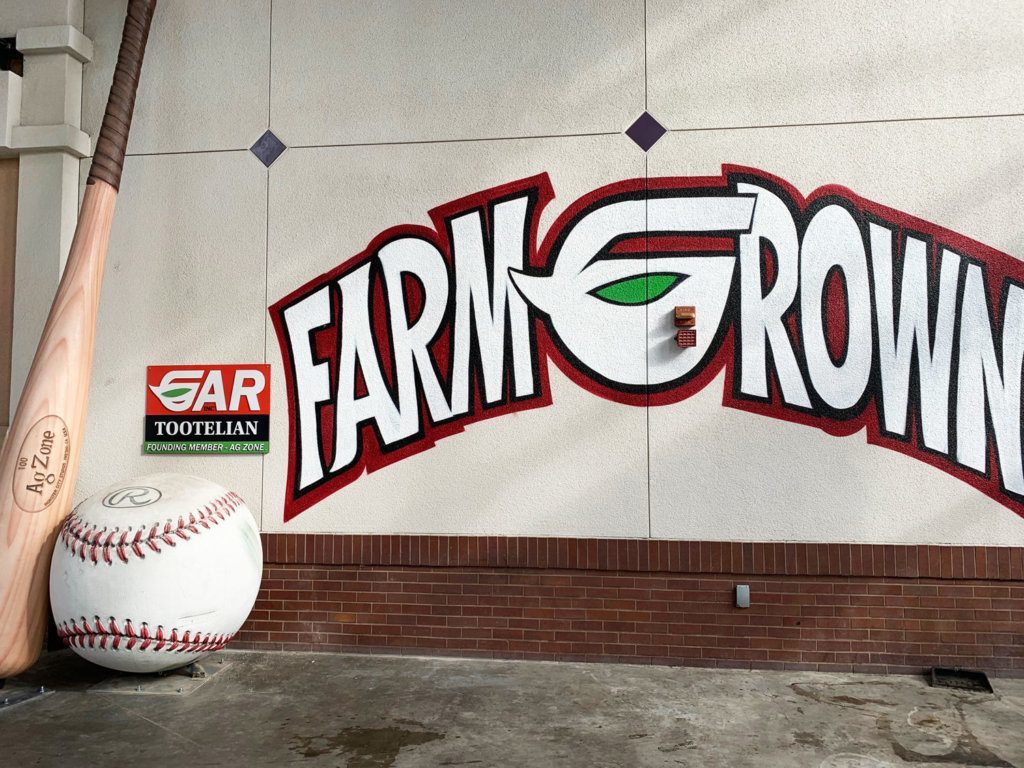
The Other California
Now is probably a good time for a disclaimer. I am not only a former employee of the Nationals, but also of the Grizzlies. Having spent time with both clubs, in both cities, this seemed like an impossible assignment to ignore.
As you clear the high desert and the snowcapped peaks of the Sierras coming from the east, the hills roll down suddenly into mile-wide squares of farmland, the kind you see at 30,000 feet on a cross-country flight, but suddenly right beneath you. Fresno is, for those who don’t live here, the flyover part of a non-flyover state.
The city’s name means “ash tree” in Spanish, the wood from which the most popular baseball bats were made for decades, before the recent surge in maple use. Fittingly, baseball has been played in Fresno professionally since 1898, though the current incarnation of Triple-A ball didn’t land in town until a century later as the Grizzlies.
Chukchansi Park, named after the local Indian casino (and local tribe of the same name), was built in the optimism and style of the late ‘90s dot-com boom, a monstrous 12,500 seats, nearly all fixed in the two-tiered bowl. A $3.4 million renovation this offseason ripped out roughly 2,000 of those seats, adding a social bar area down the left field line and a water park, berm and play area for kids on the opposite side. It’s a park just five years younger than Turner Field was, eight years younger than Globe Life Park, but one that feels modern and has aged well.
The park is smack in the middle of downtown, a triangle of freeways as if drawn freehand by a kindergartner pointing west through places you’ve never heard of like Kerman and Mendota and, eventually, once you clear both sets of hills separating it from the coastline, smack to the middle of the Monterey Bay. Or, if you’re waxing more philosophical, it’s shaped a lot like a heart — an actual heart, ventricles and all, the beating center of agriculture that feeds not just the better-known cities in the state, but the nation.
As a city, Fresno’s always been portrayed as not being big enough to be worth being the butt of so many jokes, and yet, that isn’t true — the size of the place, that is. At more than 527,000 residents, it’s more populous than New Orleans, Virginia Beach, Raleigh, Kansas City, even Atlanta. It’s even bigger than the state capitol, just two hours up California’s other, forgotten highway (no, not I-5; no, not 101).
Fresno’s also not close to anything, really. The distance from Downtown LA to Chukchansi Park is nearly as far as from Downtown D.C. to Manhattan.
But if Fresno is so unremarkable, why does everyone keep remarking on it? (Warning: language)
There are six of these videos.
“A lot of it, I think, is rooted in the idea that Johnny Carson used to make Fresno jokes a lot,” said Mike Osegueda, better known as Mike Oz, a baseball writer for Yahoo! Sports who has written about and organized cultural events in Fresno since taking a job at the Fresno Bee right out of college 17 years ago. “And that was sort of the idea that Fresno became this punchline. You would get a lot of random Fresno jokes in TV and movies, partially because it’s just kind of a funny-sounding city.”
Even Nats color commentator F.P. Santangelo couldn’t help but try to get a joke in on a recent broadcast.
“The Triple-A team should get shirts that say, ‘Escape from Fresno,’” Santangelo said.
Play-by-play man Bob Carpenter reminded Santangelo that the folks in Fresno could probably see and hear him.
They had.
“It’s just another time this has happened, because this happens a lot,” said Oz. “I understand Fresno’s an easy punchline. It’s not something that we are surprised by, or honestly at this point, even that worked up about.”
The relationship between San Francisco and LA is historically acrimonious, their baseball teams a mere avatar of that animosity. Both punch down at the state’s smaller cities — to San Jose, then to Sacramento, then to Fresno, then to Bakersfield. That pecking order lends a little extra salt to the comments from Santangelo, who grew up in Sacramento.
“Nobody wants to hear people who aren’t from here talk like that,” laughed Grizzlies GM Derek Franks. “Especially from Sacramento!”
The city has a fierce, hometown pride that the team has tapped into over the last few years. Getting dropped by the Giants was a stunner, just another rebuke from coastal California, as they opted for greener pastures in, of all places, the Pacific Coast League city just up the road: Sacramento. The Grizzlies staged a “rebellion,” coining the term Growlifornia, even flying their own, modified flag instead of the state flag at the ballpark.
“When the Giants left, we found ourselves,” said Sam Hansen, the Grizzlies director of marketing.
He knows it’s corny, but it’s true.
“We’re not the Bay Area. We’re not LA, and we don’t want to be.”
That last part may come as a relief to Nats fans, given the team’s playoff history with each of those other California cities.
***
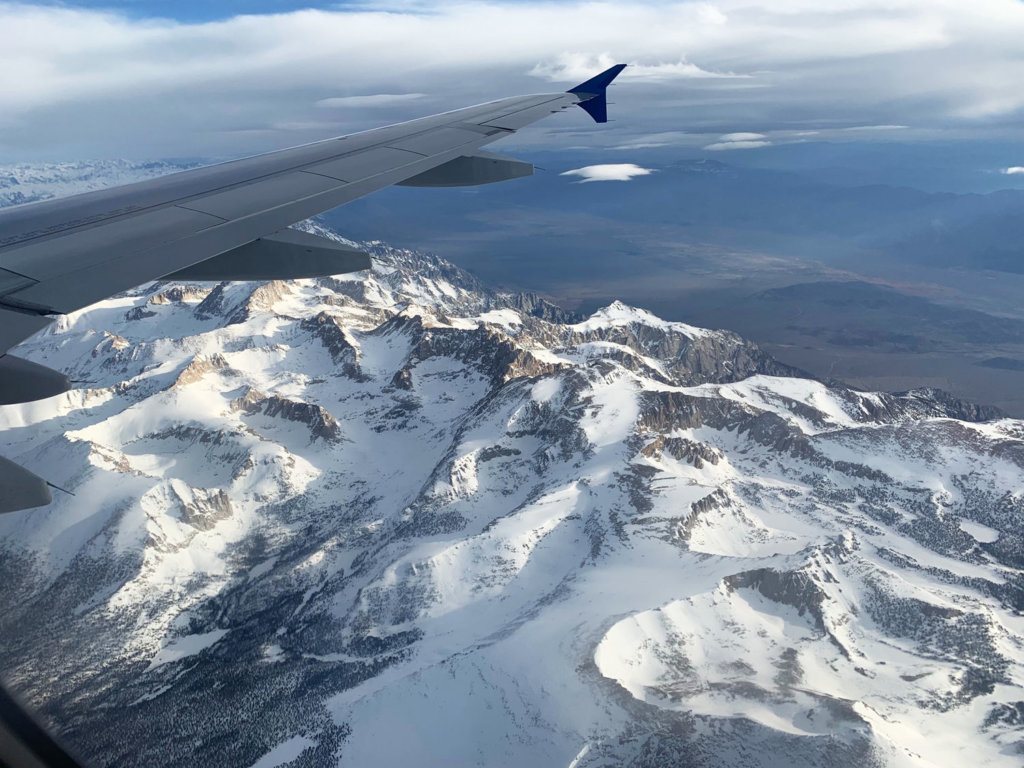
Travel
The Grizzlies understand that travel is the primary concern out East. Not only is it impossible to replace someone in the lineup on the fly who injures themselves in batting practice, but even a next day replacement requires lots of gears working together to get a player through a connecting flight — the only direct destination east of the Mississippi River is Chicago — while moving ahead three time zones.
It didn’t take long to see exactly how this all would work. On the night of Bryce Harper’s return to D.C., the other storyline was Nats shortstop Trea Turner taking a pitch off his right index finger while pulling away from a bunt attempt, which left him with a non-displaced fracture. Out west, that meant Adrian Sanchez was being booked on United Airlines Flight 1285, a redeye into Chicago — which leaves at 11:15 p.m. PT and lands at just after 5 a.m. CT — the only viable way to connect to the East Coast in time for a day game.
Sanchez made it, prompting that conversation on MASN, in which Carpenter explained the particulars of the flight.
“Yeah, that’s in high demand,” quipped Santangelo.
The route sounds like (and is — I took it home) a brutal one on the body, but it’s a logistical godsend for the Grizzlies. Just added in June of last year, it was introduced as a summer seasonal route (June-September) at first, but is now a regular flight year-round, one that the teams are already putting into regular use.
With a planned renovation and expansion of the airport in the works, there are rumors (and even a dedicated Facebook page) about the possibility of Southwest Airlines coming to town. That would not only open up a host of new flight options, but also save the hometown team a ton of money on bag fees.
Juggling travel logistics is nothing new for the Grizzlies, though. One morning in 2009, when the team was still a Giants affiliate, San Francisco was on the road a couple time zones ahead, Kevin Frandsen was out shopping at a wholesale store when suddenly he was needed. The Giants’ personnel in San Francisco worked the phones frantically to get a hold of him, while the team packed his bags for a flight set to leave in about 90 minutes. The bags got there first, but for obvious security reasons, the airline wouldn’t take them without the player, who arrived just in time before the flight’s doors closed.
It’s much less of a worry getting players back down. When someone gets optioned, they have 72 hours to report to Triple-A. Jake Noll, the first to make the trip the other way, was officially optioned on Thursday, April 4, the day after drawing a walk-off walk to help the Nats beat the Phillies, 9-8. He was already in Fresno for the end of their Opening Night, having connected through Salt Lake City earlier that day, extra-inning victory on Thursday and into the lineup Friday for his Triple-A debut. That’s just one way that Fresno will be a new experience for him.
“I’ve never been on the West Coast,” said the 25-year-old Florida native. “I’m not really familiar with this area … I’ve heard the ball flies out here, too, so I’m excited to experience that.”
Even players who grew up in California aren’t really familiar with Fresno, though. Joe Ross’s teammates thought playing in Fresno meant going home for him. But Oakland’s 180 miles from Chukchansi Park, basically the distance from Washington to Norfolk.
“I’ve played in Fresno one day in my whole life,” said Ross. “We had like two or three games, a summer ball tournament type of thing.”
On Saturday night, Ross himself was on that very United redeye, headed through Chicago to New York to give the Nationals an extra arm in the bullpen. A rough performance aside, the team was lucky to even get him there at all — contrary to Santangelo’s sarcastic assumption, the flight was completely full.
***
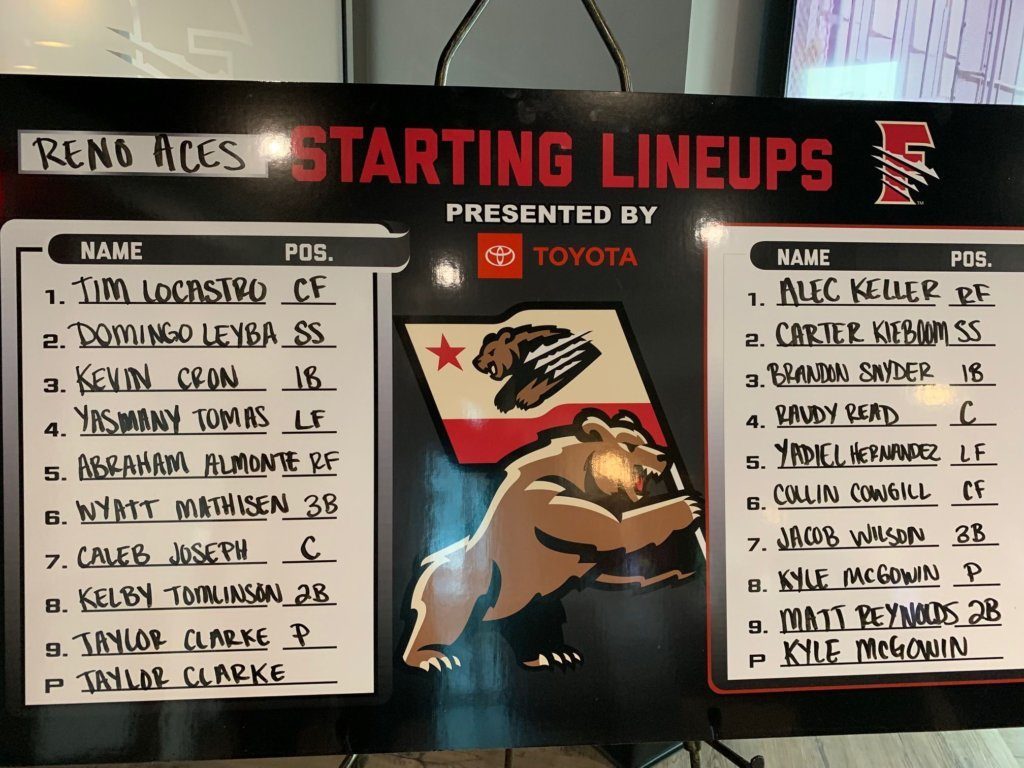
The Future
Grizzlies manager Randy Knorr is no stranger to Fresno. It’s where he played his final game and took his final professional at-bat as a player, back in 2004. And if he was disappointed to be there, there was no sign of it following an Opening Night, walk-off win over the Reno Aces, despite extra innings and a nearly 20-minute power delay when the lights on the right side of the stadium went out in the ninth inning.
“The guys love it here,” said Knorr, citing the multiple lakes that allow them to fish, a popular pastime.
But perhaps the biggest overlooked advantage is the weather. The summers get quite hot, but it’s always baseball weather in the Central Valley.
“It’s not even snowing!” laughed Knorr on Opening Night, saying he wasn’t worried about the triple-digit days to come. “You can always cool off, but it’s hard to get warm.”
Franks echoed Knorr’s assessment when it comes to the positives that many fans might not consider.
“Everybody loves the West Coast. The Astros said it, the Nats said it. The West Coast has great baseball weather,” he said. “We don’t pull tarp that often, you can keep guys on schedule. That’s important, and especially I think as teams get more analytical, keeping guys in routines is important.”
Franks also said that Nationals director of player development Mark Scialabba mentioned the team’s on-field success in their first conversation. Not only did the Grizzlies win the Pacific Coast League in both 2015 and 2018, their parent clubs have won four World Series titles in the last nine years. While it’s hard to assign a value to the organization, the ballpark, and the weather for all of that, there’s a winning tradition and an exuberant fan base.
A western pro scout from a rival National League team who has covered Fresno as part of his territory for the last seven years believes it’s actually a great place for a team to end up, putting it “right at the top” of his list. Despite the limited destinations, he noted the airport is a good one to fly into, just minutes from the park, and that the ballpark is still beautiful.
That’s not a word you hear associated too much with the town. But on a clear night, when the wind or a passing shower pushes the agricultural smog out, the Sierra Nevadas tower in the distance, providing a scenic backdrop to downtown.
Franks sees the optics from the outside, hears the snide remarks about his hometown, and understands the knee-jerk reaction from some Nats fans who want to see the team somewhere, anywhere closer to home.
“We don’t feel that way at all,” he said, citing the successful flight through Chicago as well as the ease of travel for VP and senior adviser Bob Boone, up for the opening series from his home in San Diego. “We look at the logistics of travel as partners as not as great of a challenge as everybody makes it out to be, fully acknowledging that it’s much easier and much more common to be close. But we’re excited. We want to keep the same affiliate.”
It’s unclear at this point how long that affiliation will last. And while the travel is tough, baseball-wise, there is a number of advantages. You can roll your eyes if you want — Fresno’s used to it. There are plenty worse places to be.

